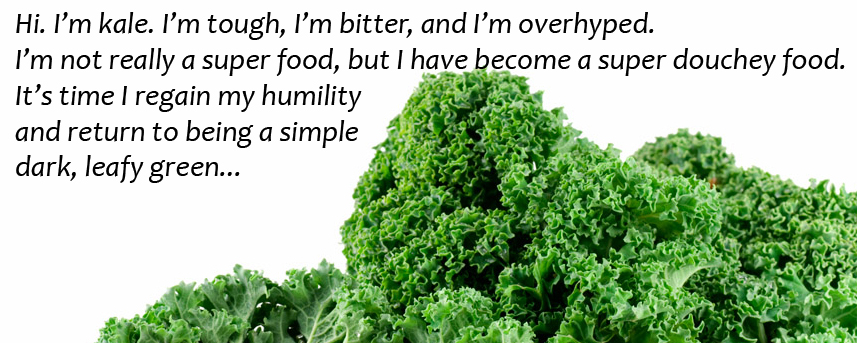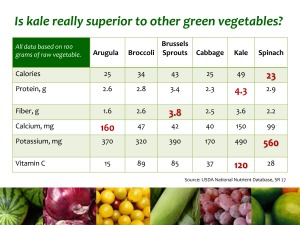By Amy Myrdal Miller, MS, RDN
Founder & President of Farmer’s Daughter Consulting…and well-known kale hater…
‘Tis the season for love, but I’ve been thinking the past few days about things I hate, like ingredients that capture the attention of chefs, product developers, women’s magazines, and home cooks and dominate our food conversation for far too long. Ingredients like quinoa, chia seeds, agave, and kale have been obsessively and passionately used in recipes and products the past few years. It’s time to stop. And think.
Are these ingredients better than alternative ingredients? Are the claims true? And is the use appropriate? I cringe when I see recipes titled “Mediterranean Quinoa Salad.” Quinoa comes from the Andes. It can only grow in high elevations. It has never been part of traditional Mediterranean cuisine. But in an attempt to capture the attention of the virtuous, health-seeking consumer who really has no clue, well meaning recipe and product developers will force these pairings, knowing that certain terms like “Mediterranean” and “quinoa” mean “better-for-me” in the eyes of the confused consumer.
Many who know me know that I’ve been privately rolling my eyes at much of the quinoa and agave silliness, and then publicly raging about kale. It’s not that I hate kale; I just hate all of the undeserved attention for what used to be a humble, dark leafy green that is great in soups.
What is it about kale that so many find so appealing? And why in the world is there a National Kale Day? To celebrate what? Its movement from salad bar garnish to center of the plate superstardom?
My husband and I watched the movie St. Vincent a few nights ago, and there was a line at the end of the movie delivered sarcastically by Bill Murray’s character that had me laughing out loud as the movie wrapped up and we left the theater. The line was “Well, this food is better than hunger” and I thought that’s what I think about kale.
While some may claim they like the flavor or texture, I think they like how virtuous they feel when they eat kale. Often referred to as a superfood, kale is no better than other dark leafy greens. In fact, as the following chart shows, each green vegetable has a unique nutrition attribute. Some are lower in calories, others richer in nutrients of concern like fiber and potassium.
Seriously, kale is not a vegetable with appealing flavor unless it’s accompanied by more interesting, flavorful ingredients that counterbalance kale’s tough, bitter, off-putting personality. Consider kale’s cousin the collard green. Collards have been mastered by southern home cooks who recognize that stewing the collards in a smoky ham hock bath creates appealing deliciousness.
There are only two kale dishes I’ve eaten the past 10 years that are worth mentioning. One was a Kale Caesar Salad where the kale had been blanched, put in an ice bath to stop the cooking, cut into thin strips, and then tossed in a very lemony Caesar dressing. The salad also included warm croutons that had been generously doused in an extra virgin olive oil with minced garlic. The kale wasn’t the hero of this salad; it was those croutons whose rich flavor and appealing texture enticed the diner to take bite after bite. Would this salad have been as good with Romaine? No. It probably would have tasted even better. But the chef who created this salad claims the use of kale on his menu changed the minds of many a “fooderati” diner who wouldn’t dare order a classic Caesar but would virtuously order a Kale Caesar and then tweet about it for days.
The other dish was a layered breakfast casserole that combined whole wheat French bread, eggs, half & half, Gruyere, and kale that had been de-stemmed, chopped, and sautéed in extra virgin olive oil. Again, kale wasn’t the reason this upscale egg bake was so delicious. It was the good quality bread, and the richness of the dairy products. The nuttiness of the Gruyere balanced out the bitter notes from the kale. And of course the crunchy bits of bread that rose above the egg custard during the baking process kept the dish from being too soft and mushy.
I believe America’s love affair with kale is like any other food fad. Kale has held on longer than chia seeds, but it’s time will soon pass. And if I have my way, kale will soon be an image only in our rear view mirrors as we look forward to a future filled with a greater variety of flavorful, healthful foods that have a richer story to tell.
Cauliflower, anyone?


